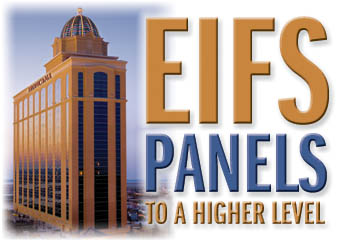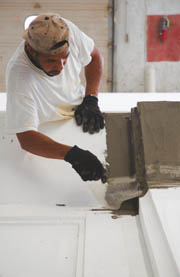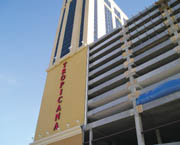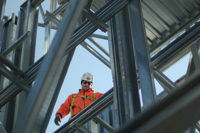
There is much information available about field-applied EIFS, in part since it is the most predominant method of application. For more than 20 years, one manufacturer of prefabricated EIFS panels has been consistently ahead of the curve in using innovations in their EIFS panels to ensure quality. Jersey Panel has manufactured panelized EIFS for many of Atlantic City's most well known casinos and resorts, including the Tropicana Hotel and Casino.
For the most part, EIFS panels and field-applied EIFS are comprised of similar materials but EIFS panels differ drastically in engineering and by the fact that the system is applied to a structural panel in a manufacturing facility. They are then trucked to the job site and erected as completed panels.
The panels, in the case of the Tropicana, varied in size with some pieces measuring 10 feet by 40 feet and weighing about four pounds per square foot-considerably less than other competitive exterior wall claddings. This lightweight system allows the structure to be built using lighter weight steel or concrete at a cost savings to the project owner.
The most effective use of panelized EIFS is on large capacity buildings and projects where speed of completion along with high-quality construction is important. For example, a high-rise project of 200,000 square feet of exterior surface area can be enclosed with EIFS panels in about two months.
According to Dominick Baruffi, Jersey Panel CEO, when comparing EIFS panels with other exterior claddings, the biggest challenge is the lower cost of EIFS.
"People assume that lower cost equals lower quality," Baruffi says. "And it's really the exact opposite. We are so far from the cost of our nearest competitor and yet so far superior in quality, design flexibility and, ultimately, bottom line efficiency."

Lay the Ground Work
In the spring of 2005, a fourth tower addition was completed at the Tropicana Hotel and Casino in Atlantic City, N.J. This was also the third time EIFS prefabricated panels were used on Tropicana projects. The repeated use of EIFS panels manufactured by Jersey Panel clearly demonstrates the owner's satisfaction with this cladding. This addition was approximately 250,000 square feet of exterior surface area and composed of about 1,000 panels.When the idea for the tower was conceived, the owner had a clear vision of the look he wanted. The new addition was to have a colonial Havana theme. In order to achieve the desired outcome, SOSH Architects, in Atlantic City, brought Brad Statler, president of Keating Building Corp., of Philadelphia, into the pre-construction discussions as construction manager. Soon after, Jersey Panel was brought in as a resource for value engineering, designing and specifying the project.
SOSH designed and specified the project as a panelized EIFS job from the beginning.
"There was very little discussion about the cladding to be used on the project," explains Bill Salerno, principal of SOSH. "The past performance of the product on the existing Tropicana towers left no question in our minds about using the same cladding again."
As the construction manager, Statler agreed that the benefits of prefabricated EIFS panels made the decision to use them again very simple.
"With prefabricated EIFS panels, scheduling is much simpler, costs are reduced and the project is completed much quicker," says Statler. "Winter conditions aren't an issue either because panels can be erected in practically any weather."
Color and texture were also key factors for choosing the EIFS panels, according to Salerno. The look that was trying to be achieved couldn't be accomplished with just any cladding.
These benefits to the construction manager and the architect made panelized EIFS easier to work with, but the quality in the panel manufacturing added extra value as well.

A different approach
Jersey Panel worked closely with Keating and SOSH in the pre-construction phase to help value engineer the project. Originally, the Tropicana tower was specified as a water-managed system but with Baruffi's involvement at an early stage, the spec was changed.Baruffi explains that while the EIFS industry encourages the use of water-managed systems, which works well when installed properly on the right type of building, it is not the proper system to use for high-rise panel jobs.
"We have our own water-managed system," he says. "We keep water out of each individual panel."
When Jersey Panel discovered that the job was specified and designed with a water-managed system, Statler says the two of them worked together to convince the architect to change the spec to be a standard PB EIFS panel.
"Dominick feels very strongly that a water managed EIF system is not the best choice for a panelized high-rise project," explains Statler. "He didn't even know if he would get the job yet, but he persuaded them to change the spec in the best interest of the project."
Even though there are no industry standards specifically for panelized EIFS, one would assume that the details for field applied EIFS would work for prefabricated panels. Jersey Panel goes beyond those details and includes some extra steps in their manufacturing and erection process to ensure that no water gets into a panel.
"We really take a very different approach compared to traditional EIFS," says Baruffi.
When manufacturing the panels, Jersey Panel incorporates a liquid applied air and weather barrier, Senershield-R, over the sheathing prior to applying the rest of the system. This additional weather barrier is not specified in standard PB EIFS details. It's one of the extra steps that Baruffi makes standard practice in his panel manufacturing, regardless of whether or not it's been specified.
When Statler first saw how they included this extra step requiring additional material, he asked Baruffi if the additional step put him at a cost disadvantage. Baruffi explains that the long-term end result is most important and he has to feel good about the construction of the panels when it's all done.
On panel to panel joints, in lieu of the typical back wrapping technique, base coat and reinforcing mesh are adhered a minimum of three inches onto the face of the metal studs. At penetrations, the basecoat and reinforcing mesh are extended the full length of the framing member.
For added protection against water intrusion, they also install a monolithic primary and secondary backer rod and sealant joint at each panel joint location. This provides a back up in case of failure in the first backer rod and sealant joint.
"We look at this as a belt and suspenders approach to ensuring no moisture enters the panel," says Baruffi. "Furthermore we do all the engineering in house, so we ensure the quality steps are included at every phase of design, manufacturing and erection."
Do the extra steps pay off in the long run?
"I was very impressed with the extra steps," says Statler. "The people at Jersey Panel know their product and have extreme passion for what they do, and this shows in their attention to detail."
And while, Baruffi believes that the prefabricated EIFS panel application segment is still not recognized in the industry, it doesn't change his standards.
"We are trying to lead and create an industry with the type of quality approach that we take," he explains. "Standard details don't exist for panelized high-rise jobs, and we have created them for ourselves with an emphasis on quality."


Report Abusive Comment